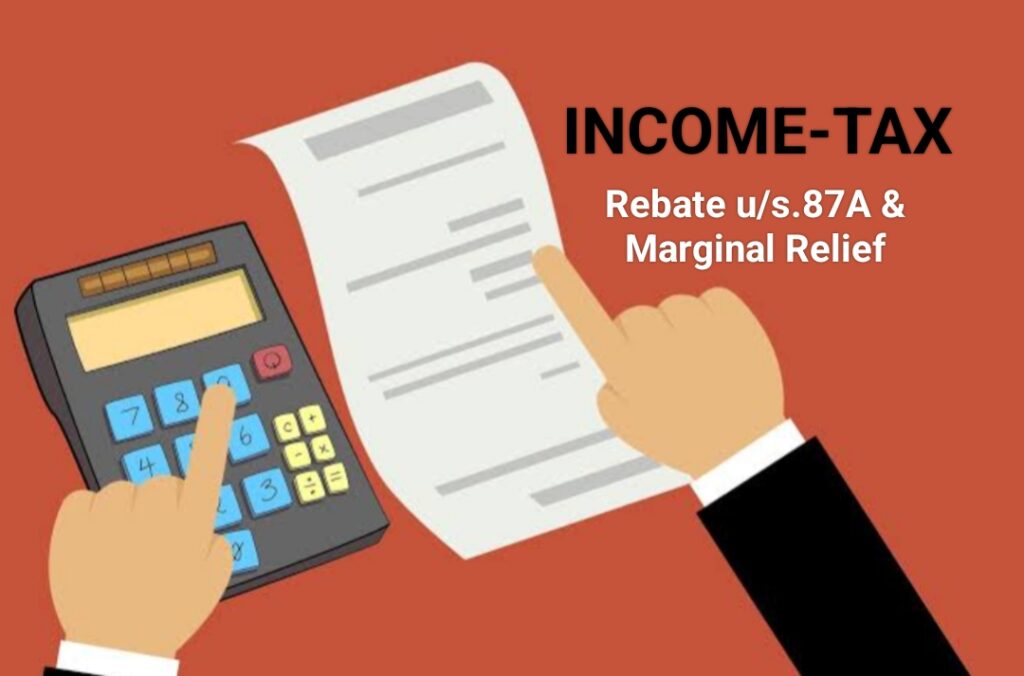The Rebate u/s. 87A reduces tax burden for low-income taxpayers, whereas marginal relief ensures that the tax does not exceed the excess taxable income over the rebate threshold.
With the Budget 2025 announcements, significant changes have been introduced to tax rebate and marginal relief provisions under the Income Tax Act, 1961. The rebate under Section 87A has been increased to Rs. 60,000 for taxpayers opting for the New Tax Regime from FY 2025-26. Additionally, marginal relief has also been introduced for specific cases. This article explores the differences between Rebate u/s 87A and Marginal Relief, their applicability, computation, and impact on taxpayers.
What is Rebate Under Section 87A?
Section 87A provides tax relief to resident individuals whose taxable income does not exceed the prescribed limits. This provision aims to reduce the tax burden on low-income taxpayers, promoting tax compliance and increasing disposable income.
Conditions for Claiming Rebate Under Section 87A
- The rebate is available only to resident individuals; Non-Residents and Hindu Undivided Families (HUFs) are not eligible.
- It is applicable under both the Old and New Tax Regimes, though the income limits differ.
- The rebate is deducted from total tax liability before applying education cess.
Rebate Limits Under Section 87A
The rebate amount varies based on the chosen tax regime and financial year:
FY 2023-24 & FY 2024-25
- Old Regime: Maximum rebate of Rs. 12,500 for taxable income below Rs. 5,00,000.
- New Regime: Maximum rebate of Rs. 25,000 for taxable income below Rs. 7,00,000.
FY 2025-26
- Old Regime: Maximum rebate of Rs. 12,500 for taxable income below Rs. 5,00,000.
- New Regime: Maximum rebate of Rs. 60,000 for taxable income below Rs. 12,00,000.
Applicability of Rebate
- Under the Old Regime, rebate u/s 87A applies to normal income as well as special-rate income like short-term and long-term capital gains (except LTCG taxable @10%).
- Under the New Regime, rebate u/s 87A is applicable only for normal income and not for special-rate income (e.g., capital gains, dividends, etc.).
What is Marginal Tax Relief?
Marginal relief ensures that the additional tax liability due to a slight increase in income does not exceed the excess income itself. This prevents taxpayers from facing a disproportionately high tax burden due to minor increases in taxable income.
Conditions for Claiming Marginal Relief
- Applicable only under the New Tax Regime.
- Only resident individuals are eligible.
- Available if taxable income slightly exceeds Rs. 7,00,000 (for FY 2023-24 & FY 2024-25) or Rs. 12,00,000 (from FY 2025-26 onwards).
- The marginal relief benefit is available for incomes up to Rs. 7,28,000 (for FY 2024-25) and Rs. 12,70,500 (from FY 2025-26 onwards).
Computation of Marginal Relief
The marginal relief is calculated as follows:
- Compute tax liability on total taxable income based on applicable slab rates.
- Compute tax on Rs. 7,00,000 (up to FY 2024-25) or Rs. 12,00,000 (from FY 2025-26). This tax is zero due to the rebate u/s 87A.
- Determine the excess income over Rs. 7,00,000 / Rs. 12,00,000.
- Calculate marginal relief as the difference between total tax liability and the excess income.
- Deduct the marginal relief from total tax liability to arrive at the final tax payable.
Difference Between Rebate u/s 87A and Marginal Relief
| Aspect | Rebate u/s 87A | Marginal Relief |
| Purpose | Reduces tax burden for low-income taxpayers | Ensures tax does not exceed excess income over rebate threshold |
| Eligibility | Resident individuals with income within limits | Resident individuals exceeding rebate limits slightly |
| Applicable Regime | Both Old and New Tax Regimes | Only New Tax Regime |
| Calculation | Deducted directly from tax payable | Computed based on excess tax over rebate threshold |
Conclusion
The increase in rebate u/s 87A and the provision of marginal relief under the New Tax Regime from FY 2025-26 provide substantial benefits to taxpayers. While the rebate ensures tax exemption for individuals earning within the specified limit, marginal relief prevents excessive taxation for those exceeding the limit by a small margin. Understanding these provisions can help taxpayers optimize their tax liabilities effectively.
Also Read

